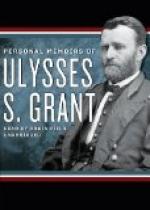At Shiloh the effective strength of the Union forces on the morning of the 6th was 33,000 men. Lew. Wallace brought 5,000 more after nightfall. Beauregard reported the enemy’s strength at 40,955. According to the custom of enumeration in the South, this number probably excluded every man enlisted as musician or detailed as guard or nurse, and all commissioned officers—everybody who did not carry a musket or serve a cannon. With us everybody in the field receiving pay from the government is counted. Excluding the troops who fled, panic-stricken, before they had fired a shot, there was not a time during the 6th when we had more than 25,000 men in line. On the 7th Buell brought 20,000 more. Of his remaining two divisions, Thomas’s did not reach the field during the engagement; Wood’s arrived before firing had ceased, but not in time to be of much service.
Our loss in the two days’ fight was 1,754 killed, 8,408 wounded and 2,885 missing. Of these, 2,103 were in the Army of the Ohio. Beauregard reported a total loss of 10,699, of whom 1,728 were killed, 8,012 wounded and 957 missing. This estimate must be incorrect. We buried, by actual count, more of the enemy’s dead in front of the divisions of McClernand and Sherman alone than here reported, and 4,000 was the estimate of the burial parties of the whole field. Beauregard reports the Confederate force on the 6th at over 40,000, and their total loss during the two days at 10,699; and at the same time declares that he could put only 20,000 men in battle on the morning of the 7th.
The navy gave a hearty support to the army at Shiloh, as indeed it always did both before and subsequently when I was in command. The nature of the ground was such, however, that on this occasion it could do nothing in aid of the troops until sundown on the first day. The country was broken and heavily timbered, cutting off all view of the battle from the river, so that friends would be as much in danger from fire from the gunboats as the foe. But about sundown, when the National troops were back in their last position, the right of the enemy was near the river and exposed to the fire of the two gun-boats, which was delivered with vigor and effect. After nightfall, when firing had entirely ceased on land, the commander of the fleet informed himself, approximately, of the position of our troops and suggested the idea of dropping a shell within the lines of the enemy every fifteen minutes during the night. This was done with effect, as is proved by the Confederate reports.
Up to the battle of Shiloh I, as well as thousands of other citizens, believed that the rebellion against the Government would collapse suddenly and soon, if a decisive victory could be gained over any of its armies. Donelson and Henry were such victories. An army of more than 21,000 men was captured or destroyed. Bowling Green, Columbus and Hickman, Kentucky, fell in consequence, and Clarksville and Nashville, Tennessee,




